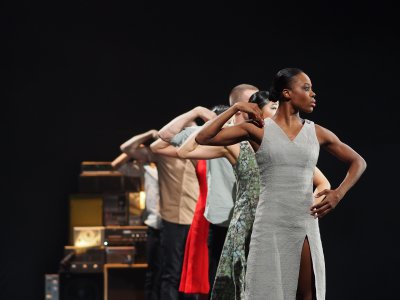Cedar Lake Contemporary Ballet: Program A
A modern ballet troupe shines brightly in its swan song season.

Raymond Pinto, Joaquin de Santana and Guillaume Queau in a scene from Richard Siegal’s “My Generation” (Photo credit: Juliet Cervantes)
[avatar user=”Joel Benjamin” size=”96″ align=”left” ] Joel Benjamin, Critic[/avatar] The Cedar Lake Contemporary Ballet has had the good fortune to have had financial security during its twelve-year existence; that is, until this year when its patron withdrew her support. The troupe’s short season at the Brooklyn Academy of Music was its swan song, but a spectacular one.
Alexandra Damiani, CLCB’s artistic director, assembled two programs, the first of which I attended. It was typical of the work identified with the company: slick, technically demanding and impeccably danced.
“My Generation,” a world premiere was choreographed by Richard Siegal to music tracks by Atom (aka Uve Schmidt) which sampled and distorted a number of songs, including the title song. Dressed in chicly layered, colorful fringed outfits (by Bernhard Willhelm), the cast was put through its paces. They seemed to be an offbeat tribe of sensualists. Small groups passed through, glancing at, but uninvolved with the central action which included one young woman, the electrifying Navvarra Novy-Williams being joyfully manhandled by a group of handsome men. (The women in the company come in for a great deal of sensual wrestling and twisty lifts and drags.) The zippy choreography seamlessly combined ballet (including point work), modern dance and a great deal of Latin hip swinging. They never paired off for more than a minute, just enough time to swing each other around. Matthew Rich, a fine dancer, was the only dancer to lip-synch a song while he did his signature bit of swinging his long hair about—a bit of self-indulgence which became tired very quickly by the end of the evening. The work felt like a party slightly out of control, the kind that only A-list beauties could attend.

Ida Saki and Jon Bond in a scene from Crystal Pite’s “Ten Duets on a Theme of Rescue” (Photo credit: Sharon Bradford)
Of the three works on the program, the second, “Ten Duets on a Theme of Rescue,” by Crystal Pite had the emotional depth and choreographic subtlety that will keep it alive in the repertory of other troupes. “Ten Duets,” set to selections from the moody film score of the film Solaris by Cliff Martinez, is, indeed, a series of duets that flow into trios and quartets. Dressed in plain street wear, the dancers pushed and pulled at each other, or slowly circled each other. The astute movements defined relationships: passive/aggressive, love besotted, angry and indifferent. At one point two pairs of lovers intertwined and came out with different partners. There were homoerotic duets and double solos hiding out as duets. The ingenious lighting by Jim French consisted of a semi-circle of non-colored spotlights on wheels, two of which were moved about by the dancers to change the chiaroscuro of each section. By the end of the work you felt deeply about these troubled people. That they had torsos of marble and high extensions was a plus, here used effectively.
Tom Waits’ depressing, but astute songs provided the sardonic score to “Rain Dogs” by Johan Inger. “Rain Dogs” began surreally with a male dancer manipulating a dated tape deck, playing some music—Mr. Waits’—and walking it back to a shelf unit filled with antique technology. Soon the music emerging from the tiny tape deck came from the theater’s sound system and others joined him. Visions of storm clouds drifted by on the rear wall; a snowstorm began and ended. The choreography was more downbeat, mirroring the pessimistic songs, the movements looser and more easygoing, seemingly springing from the songs. They paced about, falling into swirls of falls, drags, loose-limbed lifts, never quite pausing to make relationships stick. The choreographer’s sense of humor was dark, evidenced by the ending which involved a stuffed poodle going up in flames. What it all means is uncertain. Was Mr. Inger trying for some Dada statement? Who knows. The dancers looked great.
Cedar Lake Contemporary Ballet (June 3-6, 2015)
Howard Gilman Opera House at the Brooklyn Academy of Music, 30 Lafayette Avenue, in Brooklyn
For tickets call 718-636-4100 or visit http://www.BAM.org
For more information visit http://www.cedarlakedance.com
Running time: two hours including two intermissions







Leave a comment